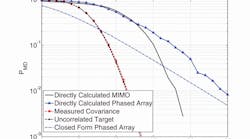Phased-array antennas have enabled many advances in the field of radar detection and jamming. Another step in the evolution of radar may be the use of multiple-input multiple-output (MIMO) technology, which utilizes spatially diverse transmitters and receivers. Mark T. Frankford, Kyle B. Stewart, Ninoslav Majurec, and Joel T. Johnson, with support from the Swedish Research Council and the Swedish Foundation for Strategic Research, recently investigated the use of MIMO radars. They found that these radars may offer enhanced performance with better tolerance to fading, as the target’s radar cross section (RCS) at the aspect angle is varied.
Through both simulation and experimentation, the researchers investigated whether MIMO radar systems could outperform phased-array radar systems in higher signal-to-noise-ratio (SNR) environments. Their simulation study used a FEKO computational electromagnetics package on a helicopter-like target at 200 MHz with two transmitters and four receivers. For the experimental study, an unmanned-aerial-vehicle (UAV) target was measured using a software-defined-radio (SDR) platform at 2.75 and 4.50 GHz.
For these two tests, the study confirmed that a MIMO radar approach performs better at high SNR values using spatially diverse antennas. Further investigation will explore the extension of Ohio State’s SDR technology to four transmit channels and four instantaneous receive channels for a deeper understanding of MIMO radar capabilities. See “Numerical and experimental studies of target detection with MIMO radar,” IEEE Transaction on Aerospace and Electronic Systems, April 2014, pg. 1569.

